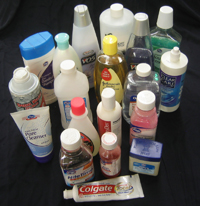 (July 2007) Ever since the plot to blow up transatlantic airplanes with liquid explosives was uncovered in London last August, pressure has increased on the airline industry—and the government—to find new ways to not only detect liquids in baggage and on passengers, but also to figure out what those liquids are. Now, the Science and Technology Directorate (S&T) is teaming with scientists at Los Alamos National Laboratory to develop a possible solution.
(July 2007) Ever since the plot to blow up transatlantic airplanes with liquid explosives was uncovered in London last August, pressure has increased on the airline industry—and the government—to find new ways to not only detect liquids in baggage and on passengers, but also to figure out what those liquids are. Now, the Science and Technology Directorate (S&T) is teaming with scientists at Los Alamos National Laboratory to develop a possible solution.
The Directorate is testing a new airport baggage screening technology that can differentiate among a variety of liquids, gels, and lotions. Called SENSIT (for “sense-it”), it already can tell the difference between some 50 kinds of fluid-type products.
“Today, when you pack for the airport, you might have to place your toothpaste tubes, shampoo bottles, and cosmetics in a sandwich bag” per the 3-1-1 Rule. “We want to make that practice a thing of the past,” says Brian Tait, who manages the SENSIT research, one of several Directorate initiatives to address liquid explosives. “And that’s going to make a lot of people very happy.”
An interim step to this goal, Tait says, is to develop the capability to screen carry-on bags that are allowed under the 3-1-1 Rule in an operational environment. In late June, he says, a Los Alamos team successfully completed a proof of concept of an extremely sensitive future screening technology that scans the magnetic changes of individual materials at the molecular level and stores them in a database. These data allow screeners to differentiate and identify many materials that may be packaged together or separately as they go through the screening process. It uses the same technology that is used to scan brains, and it is based on ultra-low field magnetic resonance imaging (MRI). The team aims to place the technology next to current X-ray screeners.
SENSIT has thus far demonstrated the ability to differentiate more than four dozen materials considered “safe” for carrying onto airplanes—from everyday personal items such as toothpaste and mouthwash to those that are considered hazardous.
“With the MRI signal, we want to distinguish between harmful items, and many common carry-on liquid consumables,” says Tait. “The goal is the reliable detection of liquids, with high throughput, that is non-contact, is non-invasive, requires no radiation, produces no residue, and uses the existing airport security portal.”
SENSIT is one of S&T’s Homeland Innovative Prototypical Solutions (HIPS)—research that has moderate to high risk but considerable promise for high payoff. “We’re working hard on getting the SENSIT technology to an airport near you very soon,” says S&T’s Innovation Director Roger McGinnis.
To request more information about this story, please e-mail st.snapshots@hq.dhs.gov.
